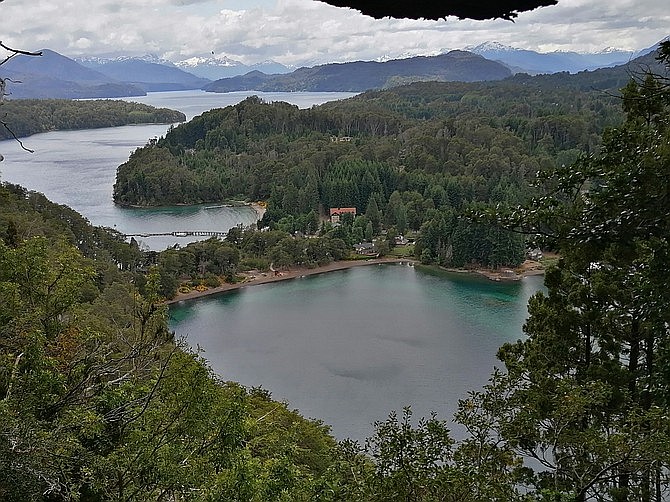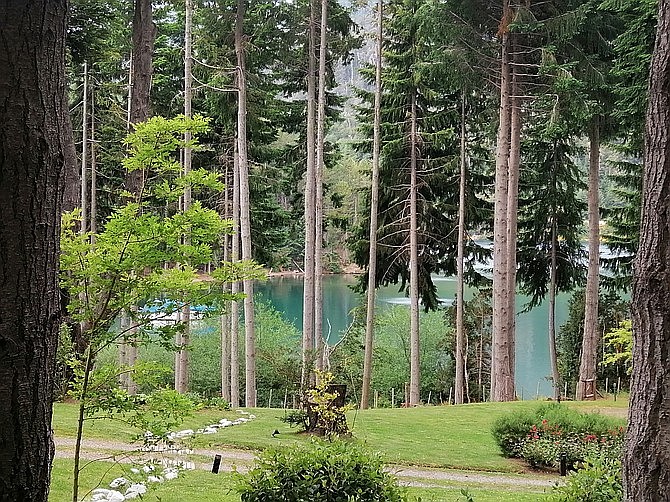 Facebook
Facebook
 X
X
 Instagram
Instagram
 TikTok
TikTok
 Youtube
Youtube

The seductive village of Villa Angostura sits between mountain and lake, Tahoe style, an hour north of Bariloche (also well worth your time) but a world apart.
Villa Angostura lies on the famed Seven Lakes route, which is actually more like seventeen. And this arm of mammoth lake #1, Nahuel Huapi, is among the prettiest rendezvous of land and water on the continent.
The peak of Cerro Bajo looms two miles away, featuring a compact but legitimate 16-lift ski mountain with an excellent reputation. The gigantic expanse of crystal blue water on three sides of the hamlet feels infinite – and for kayakers, bikers, hikers, skiers and such, the Villa is exceptional.

One of the places that draws people is the isolated Parque Nacional Arrayanes, situated on the far end of Victoria Peninsula, a long stretch of verdant woods twelve kilometers long.
This isthmus is so narrow that Isla Victoria (technically, Victoria peninsula) offers much more in the way of natural beauty than actual islands Phuket and Skye, to name a famous couple. It's absolutely undeveloped besides the 12-kilometer trail, open to hike or bike, period.

It’s a superb walk in the woods out to the stand of massive orange Arrayanes trees, by far the largest and oldest left anywhere. Most people visit the park via boats from the town docks, or across the big lake from Bariloche. The 45-minute long slow ride from the Villa is dazzling, with postcard views in every direction. It can be done round trip or one way, with a sporty hike there or back – take your pick. We took the catamaran Futaleufu, which departs from the mansa (calm) side of the isthmus.
The tariff was ARS$2600, a bargain at about US$40 for two, plus another seven dollars for the actual park admission. That’s the price for foreigners; Argentines get in for less than half of that.
Regardless, it’s worth twice the money, and we were fortunate to have Carlos as a guide and fountain of vital information. He led us around the super sturdy wooden boardwalk through the Arrayanes grove, which boasts loads of the gnarled trees, some over 450 years old. There are likely more of the distinctive orange trunks here than the rest of the planet combined, and since they’ve been spared any frivolous development or culling there are plenty that have collapsed from centuries of living.
It’s a guided walk that could take a lot longer than the scheduled half hour, with a final stop at the century-old tea house back near the dock. There’s no camping on the peninsula, so it’s made for a first-rate day hike, but the boat ride alone is something I highly recommend. A couple of eye-popping viewpoints can be reached in a half hour from the port as well, and these are likewise worth every step and minute. Two round trips every day; take your time and your camera.

We didn’t make it four kilometers up to the ski area, but did take the hourly bus to the drop-dead gorgeous Bahia Manzano.
This has to be heaven for anybody fortunate enough to own an aquatic vessel. Million-dollar pads line the forested shore and harbor here and if this ain’t good enough, it ain’t. A huge bayfront hotel takes up most of the middle, but wanderers can enjoy plenty of eye candy from the fringes. Worth a stop, at least, and maybe a tour of the shore from a sailboat with food and drinks. Stand-up paddleboards, kayaks and assorted other craft are available for hire, and I can envision a superlative day here – or many – spent gliding on the blue ribbon water, no question.
The Villa has a handful of neighborhoods all reachable via the public bus, and the main departure point is the same parking lot the long distance buses arrive at.
Rental bikes are abundant and cheap, so some human energy here can eliminate any "need" for a motorized vehicle. The main street is packed with shops and cafes, and the town, like many, fills up in January when the summer break starts. Still, the Villa is worth a few days any other time of the year, and a wide range of ecosystems are within minutes of each other. It’s a stunning location that I will return to repeatedly for further study and recreation.


The seductive village of Villa Angostura sits between mountain and lake, Tahoe style, an hour north of Bariloche (also well worth your time) but a world apart.
Villa Angostura lies on the famed Seven Lakes route, which is actually more like seventeen. And this arm of mammoth lake #1, Nahuel Huapi, is among the prettiest rendezvous of land and water on the continent.
The peak of Cerro Bajo looms two miles away, featuring a compact but legitimate 16-lift ski mountain with an excellent reputation. The gigantic expanse of crystal blue water on three sides of the hamlet feels infinite – and for kayakers, bikers, hikers, skiers and such, the Villa is exceptional.

One of the places that draws people is the isolated Parque Nacional Arrayanes, situated on the far end of Victoria Peninsula, a long stretch of verdant woods twelve kilometers long.
This isthmus is so narrow that Isla Victoria (technically, Victoria peninsula) offers much more in the way of natural beauty than actual islands Phuket and Skye, to name a famous couple. It's absolutely undeveloped besides the 12-kilometer trail, open to hike or bike, period.

It’s a superb walk in the woods out to the stand of massive orange Arrayanes trees, by far the largest and oldest left anywhere. Most people visit the park via boats from the town docks, or across the big lake from Bariloche. The 45-minute long slow ride from the Villa is dazzling, with postcard views in every direction. It can be done round trip or one way, with a sporty hike there or back – take your pick. We took the catamaran Futaleufu, which departs from the mansa (calm) side of the isthmus.
The tariff was ARS$2600, a bargain at about US$40 for two, plus another seven dollars for the actual park admission. That’s the price for foreigners; Argentines get in for less than half of that.
Regardless, it’s worth twice the money, and we were fortunate to have Carlos as a guide and fountain of vital information. He led us around the super sturdy wooden boardwalk through the Arrayanes grove, which boasts loads of the gnarled trees, some over 450 years old. There are likely more of the distinctive orange trunks here than the rest of the planet combined, and since they’ve been spared any frivolous development or culling there are plenty that have collapsed from centuries of living.
It’s a guided walk that could take a lot longer than the scheduled half hour, with a final stop at the century-old tea house back near the dock. There’s no camping on the peninsula, so it’s made for a first-rate day hike, but the boat ride alone is something I highly recommend. A couple of eye-popping viewpoints can be reached in a half hour from the port as well, and these are likewise worth every step and minute. Two round trips every day; take your time and your camera.

We didn’t make it four kilometers up to the ski area, but did take the hourly bus to the drop-dead gorgeous Bahia Manzano.
This has to be heaven for anybody fortunate enough to own an aquatic vessel. Million-dollar pads line the forested shore and harbor here and if this ain’t good enough, it ain’t. A huge bayfront hotel takes up most of the middle, but wanderers can enjoy plenty of eye candy from the fringes. Worth a stop, at least, and maybe a tour of the shore from a sailboat with food and drinks. Stand-up paddleboards, kayaks and assorted other craft are available for hire, and I can envision a superlative day here – or many – spent gliding on the blue ribbon water, no question.
The Villa has a handful of neighborhoods all reachable via the public bus, and the main departure point is the same parking lot the long distance buses arrive at.
Rental bikes are abundant and cheap, so some human energy here can eliminate any "need" for a motorized vehicle. The main street is packed with shops and cafes, and the town, like many, fills up in January when the summer break starts. Still, the Villa is worth a few days any other time of the year, and a wide range of ecosystems are within minutes of each other. It’s a stunning location that I will return to repeatedly for further study and recreation.
Comments